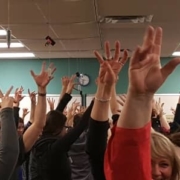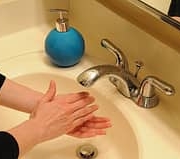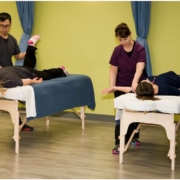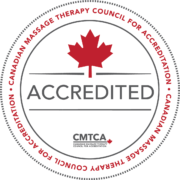Massage Therapy Career Guide
 Massage therapy is a satisfying and rewarding career that can be a perfect fit for energetic, caring people. As an RMT, you’ll enjoy all the benefits of being front-line health care professional – working closely with clients to improve and maintain their wellness – without the long hours and shift work. If you’ve received a professional massage before then you’ll have a rough idea of what the hands-on part of an RMT’s job is like. But if you’re considering becoming an RMT, that’s not all you need to know!
Massage therapy is a satisfying and rewarding career that can be a perfect fit for energetic, caring people. As an RMT, you’ll enjoy all the benefits of being front-line health care professional – working closely with clients to improve and maintain their wellness – without the long hours and shift work. If you’ve received a professional massage before then you’ll have a rough idea of what the hands-on part of an RMT’s job is like. But if you’re considering becoming an RMT, that’s not all you need to know!
What do RMTs make? Where do they work? What are the hours? To help with your research, we’ve created a massage therapy career guide to answer some of the most common questions we get from prospective students.
How much do massage therapists make?
A well-trained massage therapist can earn a very comfortable income, but exactly how much money you make will depend on your type of practice, where you are, and how much you work.
A registered therapist with a 2200-hour registered massage therapy diploma who works full time (that is, giving around 20-25 massages per week) can expect to make between $60,000-$72,000 a year. If you’re working in a city like Calgary or Edmonton, you or the clinic you work for will probably charge between $75-$100 for an hour massage (Your rates may be lower in a small town or rural area, but your expenses may be too). That said, you don’t pocket all of that. If you’re running your own clinic, you will have to cover rent, supplies, laundry, advertising, and other expenses. If you’re an employee or contractor in a spa, wellness centre, or another massage clinic, you’ll split that fee with your employer (60-40 is pretty standard). If you own a clinic and employ other therapists or practitioners, you’ll make more.
Will I be able to find a job?
Massage therapy is a fast-growing profession in Alberta and across Canada. The Alberta government rates the career’s growth prospects as “above average.” As in any profession, your personal job prospects will depend on how good a therapist you are, and what kind of training you have.
MH Vicars graduates have an extraordinarily high employment rate: in 2014, 96% of Edmonton graduates and 98% of Calgary graduates found jobs within months of graduation. We believe that our therapists do so well because of the high quality of our curriculum and our first-rate instructors.
What kind of training do I need in Alberta?
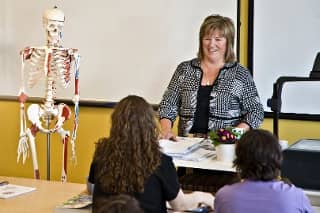 Massage therapy is not a provincially regulated profession in Alberta or Saskatchewan (the regulated provinces are BC, Ontario, Newfoundland, and New Brunswick). This means that there is no official entry-to-practice standard, and what regulation and standardization we do have is up to the professional associations and insurance companies.
Massage therapy is not a provincially regulated profession in Alberta or Saskatchewan (the regulated provinces are BC, Ontario, Newfoundland, and New Brunswick). This means that there is no official entry-to-practice standard, and what regulation and standardization we do have is up to the professional associations and insurance companies.
In Alberta, only therapists who have graduated from a 2200-hour diploma program are able to get insurance billing numbers. A therapist whose clients can’t have their receipts reimbursed will have a much harder time finding clients, but can technically still practice. After they complete their training, most massage therapists join a professional association. Different associations have difference admission standards.
But at MH Vicars School, we don’t think that counting hours is good enough. We believe that the standards should be based on what you know – competencies. This is why our 2200-hour program meets the national curriculum and delivery standards set by the Canadian Consortium of Massage Therapy Regulators, one of the few schools in Alberta to do so. We were also the first school to be placed on the Massage Therapist Association of Alberta’s Approved Programs list.
Where do massage therapists work?
Almost anywhere! Massage therapists work in many different environments, so you will have a lot of choice when you graduate: working for yourself in your own clinic or from home; with other RMTs in a dedicated massage clinic; in a wellness centre alongside doctors, chiropractors, nutritionists, acupuncturists, or other practitioners; at a gym; or at a spa or resort. Visit the job listings on our Facebook page to see the kinds of jobs employers are offering right now!
How long will my career last? Should I worry about physical burn-out?
In order to take care of others, you need to take care of yourself. Massage therapy is an active career, and like other physical professions there is a risk of occupational injuries. But most of these are highly preventable, and if you practice good technique and self-care you can plan on a long and satisfying massage career.
The key to longevity in massage therapy is good body mechanics. MH Vicars instructors are sticklers for safe technique, for good reason. Poor body mechanics can lead to exhaustion and repetitive stress injuries, not to mention a sub-par massage! It’s also important to keep fit and avoid overworking yourself.
Respect your body, choose an employer who does the same, and you’ll be comfortably massaging for years to come.
I hope this has helped answer some of your questions about what it’s like to be a massage therapist, and what you need to do to succeed! Going back to school and changing careers is a big decision, so it’s important to do as much research as you can.
Please don’t hesitate to contact us if you have any questions (1-866-491-0574 or info@mhvicarsschool.com). We also recommend that you talk to a working RMT. They will be able to offer even more insight about their day-to-day work. You can find an MH Vicars grad near you here, or book an appointment at one of our public clinics.

